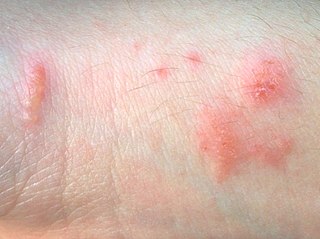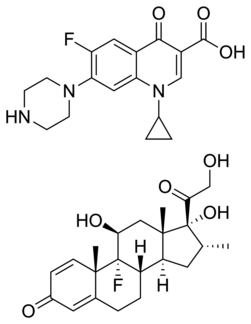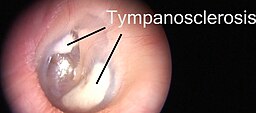Related Research Articles

Toxicodendron radicans, commonly known as eastern poison ivy or poison ivy, is an allergenic Asian and Eastern North American flowering plant in the genus Toxicodendron. The species is well known for causing urushiol-induced contact dermatitis, an itchy, irritating, and sometimes painful rash, in most people who touch it. The rash is caused by urushiol, a clear liquid compound in the plant's sap. The species is variable in its appearance and habit, and despite its common name, it is not a true ivy (Hedera), but rather a member of the cashew and pistachio family (Anacardiaceae). T. radicans is commonly eaten by many animals and the seeds are consumed by birds, but poison ivy is most often thought of as an unwelcome weed. It is a different species from western poison ivy, T. rydbergii, which has similar effects.

Cholesteatoma is a destructive and expanding growth consisting of keratinizing squamous epithelium in the middle ear and/or mastoid process. Cholesteatomas are not cancerous as the name may suggest, but can cause significant problems because of their erosive and expansile properties. This can result in the destruction of the bones of the middle ear (ossicles), as well as growth through the base of the skull into the brain. They often become infected and can result in chronically draining ears. Treatment almost always consists of surgical removal.

Urushiol is an oily mixture of organic compounds with allergenic properties found in plants of the family Anacardiaceae, especially Toxicodendronspp., Comocladia spp. (maidenplums), Metopium spp. (poisonwood), and also in parts of the mango tree as well as the fruit of the cashew tree. In most individuals, urushiol causes an allergic skin rash on contact, known as urushiol-induced contact dermatitis.

Aminoglycoside is a medicinal and bacteriologic category of traditional Gram-negative antibacterial medications that inhibit protein synthesis and contain as a portion of the molecule an amino-modified glycoside (sugar). The term can also refer more generally to any organic molecule that contains amino sugar substructures. Aminoglycoside antibiotics display bactericidal activity against Gram-negative aerobes and some anaerobic bacilli where resistance has not yet arisen but generally not against Gram-positive and anaerobic Gram-negative bacteria.

Cefixime, sold under the brand name Suprax among others, is an antibiotic medication used to treat a number of bacterial infections. These infections include otitis media, strep throat, pneumonia, urinary tract infections, gonorrhea, and Lyme disease. For gonorrhea typically only one dose is required. In the United States it is a second-line treatment to ceftriaxone for gonorrhea. It is taken by mouth.

Otology is a branch of medicine which studies normal and pathological anatomy and physiology of the ear as well as their diseases, diagnosis and treatment. Otologic surgery generally refers to surgery of the middle ear and mastoid related to chronic otitis media, such as tympanoplasty, or ear drum surgery, ossiculoplasty, or surgery of the hearing bones, and mastoidectomy. Otology also includes surgical treatment of conductive hearing loss, such as stapedectomy surgery for otosclerosis.

Urushiol-induced contact dermatitis is a type of allergic contact dermatitis caused by the oil urushiol found in various plants, most notably species of the genus Toxicodendron: poison ivy, poison oak, poison sumac, and the Chinese lacquer tree. The name is derived from the Japanese word for the sap of the Chinese lacquer tree, urushi. Other plants in the sumac family also contain urushiol, as do unrelated plants such as Ginkgo biloba.

Ciprofloxacin/dexamethasone (Ciprodex) is an antibiotic/steroid combination medication. It contains the synthetic broad-spectrum antibacterial agent, ciprofloxacin hydrochloride (0.3%), combined with the anti-inflammatory corticosteroid, dexamethasone (0.1%), in a sterile, preserved suspension for otic use.

Sulfadiazine is an antibiotic. Used together with pyrimethamine, a dihydrofolate reductase inhibitor, it is the treatment of choice for toxoplasmosis, which is caused by a protozoan parasite. It is a second-line treatment for otitis media, prophylaxis of rheumatic fever, chancroid, chlamydia, and infections by Haemophilus influenzae. It is also used as adjunct therapy for chloroquine-resistant malaria and several forms of bacterial meningitis. It is taken by mouth. Sulfadiazine is available in multiple generic tablets of 500 mg. For urinary tract infections, the usual dose is 4 to 6 grams daily in 3 to 6 divided doses.

Ear drops are a form of topical medication for the ears used to treat infection, inflammation, impacted ear wax and local anesthesia. They are commonly used for short-term treatment and can be purchased with or without a prescription. Before using ear drops, refer to the package insert or consult a health professional for the amount of drops to use and the duration of treatment.
Neomycin/polymyxin B/hydrocortisone, sold under the brand Otosporin among others, is a medication used to treat otitis externa and certain eye disorders. It consists of the antibiotics neomycin and polymyxin B, and the steroid hydrocortisone. It is used as an ear drop or eye drop.

Tec Laboratories, Inc. is a manufacturer of over-the-counter pharmaceutical dermatological preparations. The company was founded in 1977 by a former Mead Johnson executive, chemical engineer Robert L. Smith, and is headquartered in Albany, Oregon. The company's products, including its flagship poison oak scrub, Tecnu, are sold in approximately 47,000 retail outlets which have sold over 53 million units, as of 2014.

Azasetron is an antiemetic which acts as a 5-HT3 receptor antagonist, pKi = 9.27 It is used in the management of nausea and vomiting induced by cancer chemotherapy (such as cisplatin chemotherapy). Azasetron hydrochloride is given in a usual dose of 10 mg once daily by mouth or intravenously. It is approved for marketing in Japan, and marketed exclusively by Torii Pharmaceutical Co., Ltd. under the trade names "Serotone I.V. Injection 10 mg" and "Serotone Tablets 10 mg". Pharmacokinetics data from S. Tsukagoshi.

Tympanosclerosis is a condition caused by hyalinization and subsequent calcification of subepithelial connective tissue of the tympanic membrane and middle ear, sometimes resulting in a detrimental effect to hearing.

Poison ivy is a type of allergenic plant in the genus Toxicodendron native to Asia and North America. Formerly considered a single species, Toxicodendron radicans, poison ivies are now generally treated as a complex of three separate species: Toxicodendron radicans, Toxicodendron rydbergii, and Toxicodendron orientale. They are well known for causing urushiol-induced contact dermatitis, an itchy, irritating, and sometimes painful rash, in most people who touch it. The rash is caused by urushiol, a clear liquid compound in the plant's sap. They are variable in appearance and habit, and despite its common name, it is not a "true" ivy (Hedera), but rather a member of the cashew and pistachio family (Anacardiaceae). T. radicans is commonly eaten by many animals, and the seeds are consumed by birds, but poison ivy is most often thought of as an unwelcome weed.

Aluminium diacetate, also known as basic aluminium acetate, is a white powder with the chemical formula C4H7AlO5. It is one of a number of aluminium acetates and can be prepared in a reaction of sodium aluminate (NaAlO2) with acetic acid.

Otitis externa, also called swimmer's ear, is inflammation of the ear canal. It often presents with ear pain, swelling of the ear canal, and occasionally decreased hearing. Typically there is pain with movement of the outer ear. A high fever is typically not present except in severe cases.

Finafloxacin (Xtoro) is a fluoroquinolone antibiotic. In the United States, it is approved by the Food and Drug Administration to treat acute otitis externa caused by the bacteria Pseudomonas aeruginosa and Staphylococcus aureus.
Aluminium triacetate, formally named aluminium acetate, is a chemical compound with composition Al(CH
3CO
2)
3. Under standard conditions it appears as a white, water-soluble solid that decomposes on heating at around 200 °C. The triacetate hydrolyses to a mixture of basic hydroxide / acetate salts, and multiple species co-exist in chemical equilibrium, particularly in aqueous solutions of the acetate ion; the name aluminium acetate is commonly used for this mixed system.

A cerumenolytic is an ear wax (cerumen) softening agent. Common cerumenolytics such as hydrogen peroxide and hydrogen peroxide - urea are topical preparations used to facilitate the removal of ear wax. Their side effects tend to be mild, including ear discomfort, transient loss of hearing, dizziness, and local irritation.
References
- ↑ Drugs.com: Acetic acid/ aluminum acetate solution
- ↑ Thorp; Kruger, J.; Oliver, S.; Nilssen, E. L. K.; Prescott, C. A. J.; et al. (1998). "The antibacterial activity of acetic acid and Burow's solution as topical otological preparations". J. Laryngology & Otology. Cambridge University Press. 112 (10): 925–928. doi:10.1017/S0022215100142100. PMID 10211213. S2CID 29258555.
- ↑ Rinzler, Carol Ann (2010-05-12). The Encyclopedia of Cosmetic and Plastic Surgery. ISBN 9781438127026.
- ↑ Kashiwamura M, Chida E, Matsumura M, Nakamaru Y, Suda N, Terayama Y, Fukuda S (January 2004). "The efficacy of Burow's solution as an ear preparation for the treatment of chronic ear infections". Otology & Neurotology. 25 (1): 9–13. doi:10.1097/00129492-200401000-00002. PMID 14724484. S2CID 7562816.
- ↑ Kashiwamura, Masaaki; Chida, Eiji; Matsumura, Michiya; Nakamaru, Yuuji; Suda, Noriyuki; Terayama, Yoshihiko; Fukuda, Satoshi (Jan 2004). "The Efficacy of Burow's Solution as an Ear Preparation for the Treatment of Chronic Ear Infections". Otology & Neurotology. 25 (1): 9–13. doi:10.1097/00129492-200401000-00002. PMID 14724484. S2CID 7562816.
- ↑ Munguia, Raymundo; Daniel, Sam J. (April 2008). "Ototopical antifungals and otomycosis: A review". International Journal of Pediatric Otorhinolaryngology. 72 (4): 453–459. doi:10.1016/j.ijporl.2007.12.005. PMID 18279975.
- ↑ "CFR - Code of Federal Regulations Title 21" . Retrieved 16 December 2016.
- ↑ "Domeboro". dailymed.nlm.nih.gov/. U.S. National Library of Medicine.
- ↑ "FDA". www.fda.gov/.
- ↑ "About Domeboro® Astringent – Rash Treatment & Skin Irritation | Domeboro". Archived from the original on 2017-12-10. Retrieved 2015-01-08.
- ↑ "Well". The New York Times.